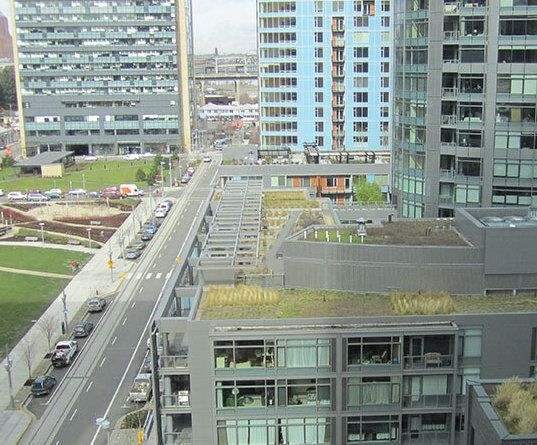Urban areas face increasing problems with stormwater management. Impervious surfaces on roads and buildings cause flooding, which impacts the water quality of streams, rivers and lakes. Green infrastructure, including features such as rain barrels, green roofs, rain gardens, and on-site water treatment, can provide affordable and environmentally sound ways to manage precipitation.
However, green infrastructure is challenging to maintain, because it is decentralized across a city and requires constant maintenance and upkeep. One way city management can address those challenges is to rely on volunteers to help maintain such features.
A new study from the University of Illinois and Reed College aims to estimate the value people place on improved water quality and storm management, and how much time and money they are willing to contribute to enjoy those benefits.
The researchers presented respondents in Chicago and Portland, Oregon, with a series of hypothetical scenarios that described ways to reduce flooding, improve water quality, and strengthen aquatic habitats in local rivers and streams.
“Our research indicates that these environmental goods produced by green infrastructure have significant monetary value, and that people might be willing to volunteer a significant amount of time to help provide those goods,” says Amy Ando, professor of agricultural and consumer economics at U of I, and one of the study’s authors.
The paper, published in the Journal of Environmental Economics and Management, used what is called a choice-experiment survey. Respondents were provided with background information about stormwater management issues, then presented with different scenarios and asked to choose between them. The study included survey responses from 334 individuals in Chicago and 351 in Portland.
Ando and co-authors Catalina Londoño Cadavid, Noehwah Netusil, and Bryan Parthum found that people are willing to make considerable contributions both in terms of time and money. For example, improved water quality is estimated to be worth about $280 a year per household. If flooding is cut in half, that benefit is estimated to be worth $300 a year. These amounts indicate how much people would be willing to pay in fees or taxes to obtain those specific benefits.
The study also showed that people may be willing to spend a considerable amount of time working to support these environmental features, especially if it directly benefits their local community.
“We were surprised at the large stated willingness to volunteer that people indicated,” Ando says. “For example, the average respondent was willing to spend 50 hours a year on an ambitious project to restore aquatic habitat to excellent condition and water quality to be swimmable.”
Comparing the results from Chicago and Portland, the researchers found little difference in monetary values; however, Portland residents were much more willing to volunteer their time for environmental benefits. Ando notes that while the research does not address why that may be the case, Portland has extensive volunteer programs in place, so there may already be a strong culture of volunteering among residents.
Ando says the surveys were designed to reduce hypothetical bias, or the likelihood that people indicate higher values than they would actually contribute. However, those techniques are developed for estimations of money spent, not for volunteer hours, so it remains uncertain if respondents would actually work as much as they indicate.
“People are used to the idea that if there is a city fee you have to pay it. But volunteering is volunteering. You can’t force people to work,” she notes.
Still, even if respondents exaggerate or overestimate their willingness to work, the results indicate that green infrastructure is considered important enough to spur considerable interest in contributing both time and money.
“The results of our paper seem encouraging to cities, indicating that they might well be able to put together a network of people that could help with decentralized management of green infrastructure,” Ando says. “It encourages them to think about systems of harnessing energy of community volunteers to help maintain green infrastructure that’s put in place to provide some of those environmental benefits.”
The research also indicated that willingness to volunteer may be driven in part by the direct utility people get from volunteering in their neighborhoods. Ando says this connection is important and should be a topic for future research.
Another takeaway from the study is the value of water quality for residents.
“Often, when cities are talking about green infrastructure, they’re very focused on flood reduction. That was not actually the biggest value that we found. We found evidence that people place very high values on improving habitat for aquatic creatures in urban rivers and streams, and in reducing water pollution so the rivers and streams are more usable by people who live near them,” Ando states.
“One of the implications of our research is that urban water managers should be focused on providing those benefits and not just worry about flood reduction,” she concludes.















